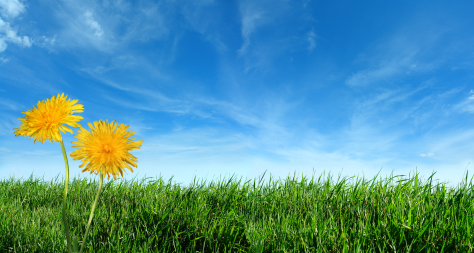
Before you get out the lawn mower, clean up a bit.

Mow high and often.

After you’ve removed any debris and thatch build-up, it’s time for the first mowing of the season. Adjust your mower to a fairly low mowing height — about 1-1/2″. This low first mowing will remove dead leaf blades and open the turf up to air circulation and sunshine. As with raking, be sure the lawn is dry before mowing. Once the first mowing is completed, you should then mow your lawn as often as necessary. Rather than following a weekly mowing schedule, base your mowing frequency on the growth rate of the grass and the “one-third rule.” The one-third rule for mowing your lawn is to never remove more than one third of the leaf blade during any one mowing. For example, the recommended mowing height for Kentucky Bluegrass in the spring is 2 inches. Therefor, the height of the grass should not exceed 3 inches before you mow it back to 2 inches. Learn more about the one-third rule here. Use the charts shown above to determine when and how often to mow your grass type.
Leave the clippings alone!
One of the most misunderstood practices in lawn care is the removal of grass clippings after the lawn has been mowed. Although your lawn may appear “cleaner” after raking or bagging grass clippings, the fact is, your lawn will benefit more if you leave the clippings right where they are. When left on the lawn, grass clippings shade the soil surface and reduce moisture loss due to evaporation. This means less need for watering during particularly dry periods. As they decompose, grass clippings also add organic matter to improve the soil structure. Perhaps most important, decomposing grass clippings return valuable nutrients to the soil, such as nitrogen, phosphorous, and potassium. (If the clippings are removed, you may need to compensate by adding fertilizer throughout the year.)
Contrary to popular belief, grass clippings do not contribute to thatch build-up. Thatch will develop if organic matter accumulates faster than it breaks down. Grass clippings are comprised mainly of water and soft tissue and decompose quickly, contributing little to thatch. The only time it is absolutely necessary to remove grass clippings is when they accumulate in a thick layer that smothers the lawn and doesn’t decompose quickly. However, by regularly cutting your grass at the recommended mowing heights (see chart), you should be able to leave grass clippings on your lawn almost all the time.
One fo the most important things to do before you get your lawn mower out for the season is to sharpen its blade. A dull blade beats and tears the grass, leaving a frayed edge that turns brown after a few days and gives your lawn a grayish appearance. Frayed grass edges also tend to lose moisture quickly and provide an entry point for disease. A sharp mower blade, on the other hand, cuts the grass cleanly and quickly — and uses less of your mower’s power, saving fuel. Learn more about how to sharpen your mower blade here.
Don’t fall into a pattern.
It’s easy to get into the habit of mowing your lawn in the same direction, following the same pattern, week after week. Don’t make this mistake. Following the same mowing pattern (in the same direction) causes soil compaction and turf wear from the mower wheels, especially with heavy riding mowers. That’s why it is also a good idea to overlap your previous cut when mowing, rather than following the wheel track you left on the last pass. By alternating the mowing pattern and direction every week or two, you’ll improve the health and appearance of your lawn.
Getting a new mower this season? Check out the DR Versa-Pro Z-Mower or a Neuton battery-electric mower!
